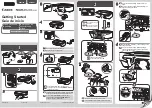
Moisture content
The amount of moisture in paper affects both print quality and the printer ability to feed the paper correctly.
Leave paper in its original wrapper until you use it. Exposure of paper to moisture changes can degrade its
performance.
Store paper in its original wrapper in the same environment as the printer for 24 to 48 hours before printing.
Extend the time several days if the storage or transportation environment is very different from the printer
environment. Thick paper may also require a longer conditioning period.
Grain direction
Grain refers to the alignment of the paper fibers in a sheet of paper. Grain is either
grain long
, running the length
of the paper, or
grain short
, running the width of the paper.
For 60–162
‑
g/m
2
(16–43
‑
lb) paper, grain long paper is recommended.
Fiber content
Most high
‑
quality xerographic paper is made from 100 percent chemically treated pulped wood. This content
provides the paper with a high degree of stability, resulting in fewer paper feeding problems and better print
quality. Paper containing fibers such as cotton can negatively affect paper handling.
Unacceptable paper
The following paper types are not recommended for use with the printer:
•
Chemically treated papers used to make copies without carbon paper, also known as carbonless papers,
carbonless copy paper (CCP), or no carbon required (NCR) paper
•
Preprinted papers with chemicals that may contaminate the printer
•
Preprinted papers that can be affected by the temperature in the printer fuser
•
Preprinted papers that require a registration (the precise print location on the page) greater than ±2.3 mm
(±0.9 in.), such as optical character recognition (OCR) forms
In some cases, registration can be adjusted with a software application to successfully print on these forms.
•
Coated papers (erasable bond), synthetic papers, thermal papers
•
Rough
‑
edged, rough or heavily textured surface papers, or curled papers
•
Recycled papers that fail EN12281:2002 (European)
•
Paper weighing less than 60 g/m
2
(16 lb)
•
Multiple
‑
part forms or documents
Selecting preprinted forms and letterhead
•
Use grain long paper.
•
Use only forms and letterhead printed using an offset lithographic or engraved printing process.
•
Avoid paper with rough or heavily textured surfaces.
•
Use inks that are not affected by the resin in toner. Inks that are oxidation
‑
set or oil
‑
based generally meet
these requirements; latex inks might not.
•
Print samples on preprinted forms and letterheads considered for use before buying large quantities. This
action determines whether the ink in the preprinted form or letterhead affects print quality.
Learn about the printer
15
Содержание XC2326
Страница 145: ...5 Insert the new print cartridge 6 Insert the print cartridge tray and then close the door Maintain the printer 145 ...
Страница 148: ...4 Insert the new manual feeder 5 Insert the tray Replacing the ADF tray 1 Open the ADF cover Maintain the printer 148 ...
Страница 149: ...2 Remove the used ADF tray 3 Unpack the new ADF tray Maintain the printer 149 ...
Страница 156: ...4 Insert the new separator pad until it clicks into place 5 Close the ADF cover Maintain the printer 156 ...
Страница 205: ...2 Lower the scanner Troubleshoot a problem 205 ...
Страница 208: ... Below the fuser area Duplex unit 3 Close the door Troubleshoot a problem 208 ...
Страница 254: ...Wi Fi Protected Setup wireless network 50 Index 254 ...
















































